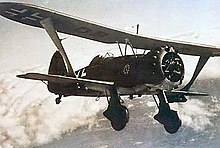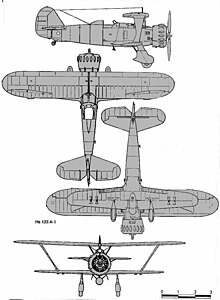
The Henschel Hs 129 was a World War II ground-attack aircraft fielded by the German Luftwaffe. The aircraft saw combat in Tunisia and on the Eastern Front.

Henschel & Son was a German company, located in Kassel, best known during the 20th century as a maker of transportation equipment, including locomotives, trucks, buses and trolleybuses, and armoured fighting vehicles and weapons.

The Messerschmitt Bf 110, often known unofficially as the Me 110, is a twin-engined Zerstörer, fighter-bomber, and night fighter (Nachtjäger) developed in Nazi Germany in the 1930s and used by the Luftwaffe during World War II. Hermann Göring was a proponent of the Bf 110, believing its heavy armament, speed, and range would make the Bf 110 the Luftwaffe’s premier offensive fighter. Early variants were armed with two MG FF 20 mm cannon, four 7.92 mm MG 17 machine guns, and one 7.92 mm MG 15 machine gun for defence. Development work on an improved type to replace the Bf 110 - the Messerschmitt Me 210 - began before the war started, but its shakedown troubles resulted in the Bf 110 soldiering on until the end of the war in various roles. Its intended replacements, the aforementioned Me 210 and the significantly improved Me 410 Hornisse, never fully replaced the Bf 110.

The Dornier Do 217 was a bomber used by the German Luftwaffe during World War II as a more powerful development of the Dornier Do 17, known as the Fliegender Bleistift. Designed in 1937 and 1938 as a heavy bomber but not meant to be capable of the longer-range missions envisioned for the larger Heinkel He 177, the Do 217's design was refined during 1939 and production began in late 1940. It entered service in early 1941 and by the beginning of 1942 was available in significant numbers.

The Henschel Hs 132 was a World War II dive bomber and interceptor aircraft of the German Luftwaffe that never saw service. The unorthodox design featured a top-mounted BMW 003 jet engine and the pilot in a prone position. The Soviet Army occupied the factory just as the Hs 132 V1 was nearing flight testing, the V2 and V3 being 80% and 75% completed.

The Henschel Hs 127 was a German bomber that was built as two prototypes, but cancelled without entering mass production.
The Bréguet 690 and its derivatives were a series of light twin-engine ground-attack aircraft that were used by the French Air Force in World War II. The aircraft was intended to be easy to maintain, forgiving to fly, and capable of 480 km/h (300 mph) at 4,000 m (13,000 ft). The type's sturdy construction was frequently demonstrated and the armament was effective. French rearmament began two years later than that in Britain and none of these aircraft were available in sufficient numbers to make a difference in 1940.
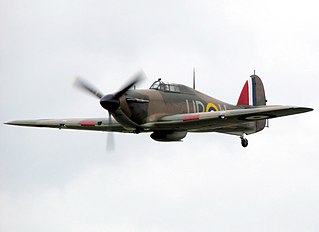
The Battle of Britain was an effort by the German Air Force (Luftwaffe) during the summer and autumn of 1940 to gain air superiority over the Royal Air Force (RAF) of the United Kingdom in preparation for the planned amphibious and airborne forces invasion of Britain by Operation Sea Lion. Neither the German leader Adolf Hitler nor his High Command of the Armed Forces believed it was possible to carry out a successful amphibious assault on Britain until the RAF had been neutralised. Secondary objectives were to destroy aircraft production and ground infrastructure, to attack areas of political significance, and to terrorise the British people into seeking an armistice or surrender.

The Henschel Hs 130 was a German high-altitude reconnaissance and bomber aircraft developed in World War II. It suffered from various mechanical faults and was never used operationally, only existing as prototype airframes.

The Henschel Hs 124 was Henschel's entry into the Luftwaffe's twin-engine Kampfzerstörer requirement, but was abandoned after this programme was split into separate Zerstörer and Schnellbomber requirements. Three prototypes were planned, but only two were built

The Heinkel He 46 was a German World War II-era monoplane designed in 1931 for the close reconnaissance and army co-operation roles. While it served with the Luftwaffe's front-line units only briefly at the start of World War II, the He 46 served as late as 1943 as a nighttime nuisance bomber and with the Hungarian Air Force.

The Heinkel He 50 was a German World War II-era dive bomber, originally designed for the Imperial Japanese Navy. Serving in Luftwaffe prewar dive-bombing units, the He 50 served until almost the end of World War II as a night harassment bomber.

The Fieseler Fi 98 was a prototype ground-attack aircraft produced by German aircraft manufacturer Fieseler as a rival to the Henschel Hs 123.
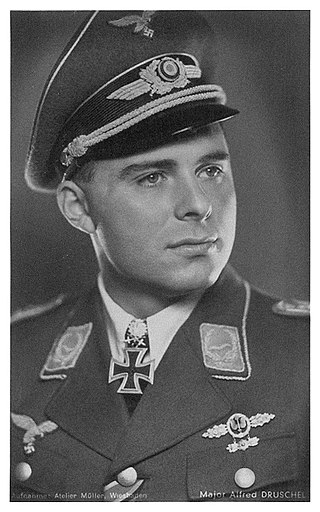
Alfred Druschel was a German Luftwaffe combat pilot during World War II. He was a recipient of the Knight's Cross of the Iron Cross with Oak Leaves and Swords of Nazi Germany.

The Bordkanone 3,7 was a German 3.7 cm (1.46 in) anti-tank/bomber autocannon of World War II and based on the earlier 3.7 cm (1.46 in) 3.7 cm Flak 18 made by Rheinmetall.

Schlachtgeschwader 1 was a German Luftwaffe wing during World War II. It operated the Henschel Hs 123, Henschel Hs 129, Focke-Wulf Fw 190, and the Messerschmitt Bf 109.
Lehrgeschwader 2 was a Luftwaffe unit during World War II, operating three fighter, night fighter, reconnaissance and ground support Gruppen (groups).
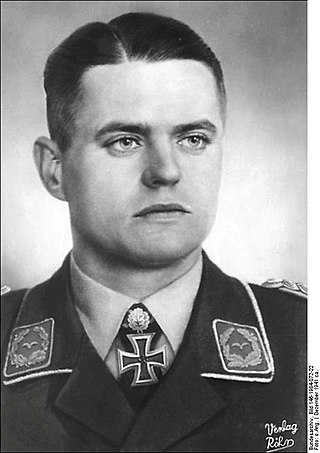
Otto Albert Bernhard Weiß was a World War II Luftwaffe attack aircraft pilot and recipient of the Knight's Cross of the Iron Cross with Oak Leaves. He was the first attack aircraft pilot so honored. Weiß flew more than 500 combat missions with the Henschel Hs 123 and the Messerschmitt Bf 109.
The IAR 471 was a Romanian World War II prototype of ground attack aircraft and dive bomber aircraft built in 1943 by Industria Aeronautică Română (IAR).


